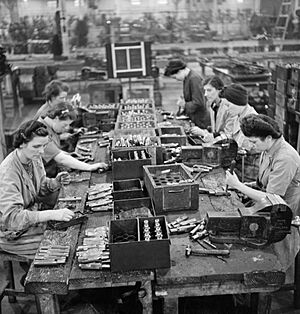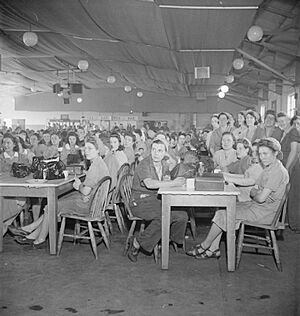Royal Ordnance Factory facts for kids
The Royal Ordnance Factories (often called ROFs) were special factories in the UK. The British government ran them during and after World War II. These factories made munitions, which are military supplies like bombs and bullets. There were three main kinds of ROFs: engineering, filling, and explosives factories. They were spread out across the country to keep them safe. The government departments in charge changed over time. Eventually, in 1987, these factories became private companies.
Contents
Why the Factories Started
Before the 1930s, Britain made most of its military supplies in one big place. This was the Royal Arsenal in Woolwich, near London. Different parts of the Arsenal were called 'Royal Ordnance Factories'. For example, there was a Royal Ordnance Factories Football Club in 1893.
However, a new danger appeared: air strikes. The government realized it was risky to have all its factories in one spot. If an enemy bombed Woolwich, Britain would lose its ability to make weapons. So, they decided to build new factories in different places across the country.
Building New Factories
Most of the new ROFs were built just before World War II started. This was part of Britain's plan to get ready for war. The older factories in Woolwich, Waltham Abbey, and Enfield were all near London. This made them easy targets for enemy planes.
The Royal Arsenal helped design many of the new factories. They also managed the building of factories that made rifles and small arms ammunition. Other government groups and private companies helped build the rest.
Private Companies Helping Out
Some factories that made explosives during World War II were owned by a company called Imperial Chemical Industries (ICI). These were not officially called ROFs. However, ICI also managed some factories that the government paid for. These were known as "agency factories."
Other ROF filling factories were also managed by private companies. These companies were not usually involved in making explosives. For example, a food company, J. Lyons and Co., ran ROF Elstow during the war. Other companies like Imperial Tobacco and Lever Brothers also helped manage these important factories.
Where the Factories Were Built
The new ROFs were built in places considered "relatively safe." Before 1940, this meant areas west of a line from Bristol to Linlithgow, Scotland. London and the East of England were seen as "dangerous." Even the English Midlands were considered "unsafe." This idea of "safe" areas changed later.
Choosing the right spot for each factory was very important. Factories making or filling explosives needed to be far from towns. They also needed good transport links, like railways. There had to be enough workers nearby and a lot of clean water. To avoid problems with frozen explosives, they were usually built near sea level. Some factories were built in Wales and Scotland because these areas had high unemployment in the 1930s. The factories were protected by the Ministry of Defence Police.
What the Factories Made
The Royal Ordnance Factories were set up to make different things. There were six main types:
- Engineering factories
- Explosives factories
- Filling factories (which put explosives into bombs and bullets)
- Medium Machine Shops (like ROF Patricroft)
- Rifles factories (like ROF Fazakerley and ROF Maltby)
- Small arms ammunition (SAA) factories
The biggest factories were usually the explosives and filling factories. They needed a large safety zone around them. This was to protect people in case of an accident. For example, ROF Bishopton was over 2,000 acres, and ROF Chorley was 900 acres.
How the Factories Were Run
Each ROF was mostly self-sufficient. They had their own power stations to make steam and electricity. They also had workshops for engineers, plumbers, and electricians. Many even had housing and hostels for workers. There were canteens, laundries, and medical centers too.
The ROFs were focused on making things. The actual design of explosives and weapons happened at separate government research places. These places were like the Research Department at the Royal Arsenal.
The Workforce
In 1942, about 300,000 people worked in the 42 Royal Ordnance factories. A large number, 60%, were women. Many of these women were young, having just finished secondary school. There were some worries about too many workers living in hostels designed for fewer people. People also wanted to make sure there was enough open space in the hostels. This was in case workers' homes were destroyed during air raids.
After the War
Factories Closing Down
Some ROFs were meant to be "temporary." They were only used during the war and closed soon after. Other factories were "permanent" and stayed open longer. In 1957, a government plan led to many changes in the military. This caused several "permanent" ROFs to close in the late 1950s, after the Korean War. More factories closed in the 1970s. The very large Royal Arsenal in Woolwich closed in 1967.
When these factories closed, other government groups often took them over. Some became places to store ammunition. Others turned into industrial areas or trading estates. Some even became sites for prisons. For example, part of ROF Thorp Arch became a storage place for the British Library. Three hostels from ROF Swynnerton became a training school for the Post Office, which is now British Telecom.
Becoming a Trading Fund
In 1974, the Royal Ordnance Factories became a "trading fund." This meant they had more freedom to manage their own money. They could act more like a business, even though they were still government-owned.
Factories Become Private
In the 1980s, the UK government decided to sell off most of the remaining ROFs. This process is called privatisation. Some of the research and development parts of the military were moved into the ROFs before they were sold.
On January 2, 1985, most of the Royal Ordnance Factories became a new company called Royal Ordnance plc. This company was then bought by British Aerospace in 1987. The Ministry of Defence Police, who guarded the factories, left most of them around the time of privatisation.
A few ROFs that made parts for nuclear weapons were kept separate. These factories, like ROF Burghfield and ROF Cardiff, did not become part of Royal Ordnance plc. They were put under the control of the Atomic Weapons Establishment.
See also



